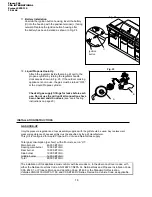
4
BEFORE LIGHTING
Inspect the gas supply hoses prior to turning on the gas. If there is evidence of cuts, wear, or abrasion, it must
be replaced prior to use.
Only the pressure regulator and hose assembly supplied with the unit should be used. Never substitute
regulators for those supplied with the grill. Contact customer service for proper replacement.
Screw the regulator (type QCC1) onto the cylinder. Leak check the hose and regulator connections with a soap
and water solution before operating the grill (See “Leak Testing” instructions on page 20).
Do not turn on the gas at the LP gas cylinder unless the quick connect gas hose is properly connected to the
side burner gas pipe system and all burner valves are in the “OFF” position.
Keep a spray bottle of soapy water near the grill and check the connections before each use.
WARNING
Do not leave the grill unattended while cooking.
WARNING
Failure to properly place the burner over the orifice
could cause a fire to occur behind and beneath the
valve panel, thereby damaging the grill and making
it unsafe to operate.
WARNING
Spiders and insects can nest inside the burners
of the grill and disrupt gas flow.
Inspect the grill at least twice a year.
CAUTION
When using a match to light the grill, make sure to
use the attached lighting rod.
CAUTION
When using the rotisserie burner, remove the
warming rack. High heat from the burner may
cause the warming rack to bend.
CAUTION
Before cleaning, make sure the gas supply and
control knobs are in the “OFF” position and the
burners have cooled.
CAUTION
The grill head is heavy and will require two or
more people to lift and position onto grill cart.
LP GAS CYLINDER WARNING
1
. Do not store or use gasoline or other flammable vapors and liquids in the vicinity of this or any other
appliance.
2
. A liquid propane cylinder not connected for use should not be stored in the vicinity of this or any other
appliance.
3
. Do not store spare liquid propane gas cylinders under or near this appliance.
4
. Never fill the cylinder beyond 80 percent capacity.
5
. Liquid propane cylinders must be fitted with an Overfill Protection Device (OPD).
6. If the information above is not followed exactly, a fire resulting in death or serious injury could occur.
Figure 246
CSA INTERNATIONAL
Project 2078110
5 of 46




































